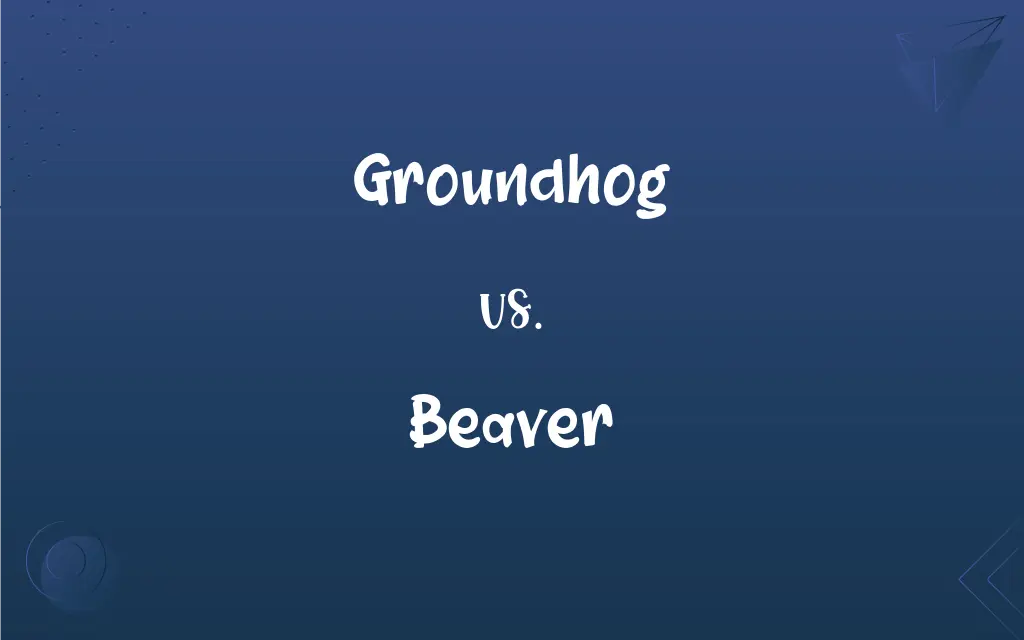Groundhog vs. Beaver: What's the Difference?
Edited by Aimie Carlson || By Janet White || Published on January 19, 2024
Groundhogs are rodents known for burrowing and hibernating, while beavers are large rodents famous for building dams and lodges in waterways.

Key Differences
Groundhogs, also known as woodchucks, are part of the squirrel family and are known for their burrowing habits. Beavers, on the other hand, are the second-largest rodents in the world and are renowned for their skill in building dams and lodges in rivers and streams. Both are noted for their impact on their respective ecosystems.
Groundhogs have a stocky build with short legs and are primarily found in North America. Beavers are distinguished by their large, flat tails and strong teeth, adapted for cutting trees and vegetation. Their physical features are specialized for their unique lifestyles.
Diet-wise, groundhogs are mostly herbivores, feeding on a variety of vegetation. Beavers are also primarily herbivorous but are particularly known for gnawing on wood, which aids in both their nutrition and dam-building activities. Their diets reflect their ecological roles.
In terms of behavior, groundhogs are known for hibernating during winter, a trait not observed in beavers. Beavers, instead, remain active throughout the year, storing food and maintaining their structures. These behavioral differences are key to understanding their survival strategies.
Groundhogs are often seen as solitary outside of the breeding season, whereas beavers are highly social, living in family groups. The social structures of these animals are adapted to their environmental needs and lifestyle.
ADVERTISEMENT
Comparison Chart
Physical Characteristics
Smaller, stocky build with short legs.
Larger with a flat tail and strong teeth.
Habitat
Burrows in the ground, mainly in open fields.
Builds dams and lodges in rivers and streams.
Diet
Primarily herbivorous, eating vegetation.
Herbivorous, known for gnawing on wood.
Behavior
Hibernate during winter.
Active all year, does not hibernate.
Social Structure
Mostly solitary except during breeding.
Live in family groups, highly social.
ADVERTISEMENT
Groundhog and Beaver Definitions
Groundhog
A member of the squirrel family, also called a woodchuck.
I spotted a groundhog, or woodchuck, in the backyard.
Beaver
A large, aquatic rodent known for building dams and lodges.
The beaver was busy constructing a dam in the stream.
Groundhog
An animal famous for its role in Groundhog Day folklore.
The groundhog saw its shadow, predicting more winter.
Beaver
A social animal that lives in family groups called colonies.
A family of beavers worked together on their lodge.
Groundhog
A creature with a stocky build and a preference for open fields.
A groundhog was seen foraging in the open field.
Beaver
An animal with a unique ability to alter its environment.
The beaver's dam-building activities changed the landscape.
Groundhog
A North American rodent known for burrowing and hibernation.
The groundhog emerged from its burrow in early spring.
Beaver
An animal with a distinctive flat tail and strong teeth.
The beaver used its strong teeth to cut through the wood.
Groundhog
An herbivorous rodent with a varied diet of grasses and plants.
The groundhog was busy eating plants in the garden.
Beaver
A herbivorous mammal that plays a key role in ecosystem engineering.
Beavers help create wetlands beneficial to many species.
Groundhog
See woodchuck.
Beaver
Either of two large semiaquatic rodents, Castor canadensis of North America or C. fiber of Eurasia, having thick brown fur, webbed hind feet, a broad flat tail, and sharp incisors used for gnawing bark and felling trees, with which they construct dams and underwater lodges.
Groundhog
A red-brown marmot, Marmota monax, native to North America.
Groundhog
(rare) The aardvark.
Groundhog
A reddish brown North American burrowing marmot (Marmota monax), also called the woodchuck. It hibernates in the winter.
Groundhog
Reddish brown North American marmot
FAQs
Are groundhogs good swimmers?
Groundhogs are capable swimmers, although they prefer land.
Do beavers eat fish?
No, beavers are herbivores and do not eat fish.
How long do beavers live?
Beavers can live up to 24 years in the wild.
How big can beavers grow?
Beavers can weigh up to 60 pounds and grow over 3 feet long.
Are beavers active in winter?
Yes, beavers remain active in winter, living off stored food.
What is the main diet of a groundhog?
Groundhogs primarily eat vegetation like grasses and plants.
Can groundhogs predict the weather?
No, the Groundhog Day tradition is folklore, not scientific.
Do groundhogs climb trees?
Yes, groundhogs can climb trees to escape predators or find food.
What materials do beavers use for their dams?
Beavers use wood, stones, and mud to construct their dams.
How deep are groundhog burrows?
Groundhog burrows can be up to 6 feet deep and 20 feet long.
Can beavers build multiple dams?
Yes, beavers often build several dams to create a complex habitat.
Do groundhogs have any natural defenses?
Their primary defense is burrowing to escape predators.
Can groundhogs cause property damage?
Yes, their burrowing can damage gardens and undermine structures.
Do beavers mate for life?
Beavers are monogamous and often mate for life.
Do beavers hibernate?
No, beavers do not hibernate but remain active all year.
How do beavers help the environment?
Beavers create wetlands that benefit various wildlife species.
Are groundhogs solitary animals?
Yes, except during mating season, groundhogs are mostly solitary.
Are groundhogs found only in North America?
Yes, groundhogs are native to North America.
Do beavers have any special adaptations for aquatic life?
Beavers have webbed hind feet and a flat tail for swimming.
What predators do groundhogs have?
Predators include foxes, hawks, and humans.
About Author
Written by
Janet WhiteJanet White has been an esteemed writer and blogger for Difference Wiki. Holding a Master's degree in Science and Medical Journalism from the prestigious Boston University, she has consistently demonstrated her expertise and passion for her field. When she's not immersed in her work, Janet relishes her time exercising, delving into a good book, and cherishing moments with friends and family.
Edited by
Aimie CarlsonAimie Carlson, holding a master's degree in English literature, is a fervent English language enthusiast. She lends her writing talents to Difference Wiki, a prominent website that specializes in comparisons, offering readers insightful analyses that both captivate and inform.






































































